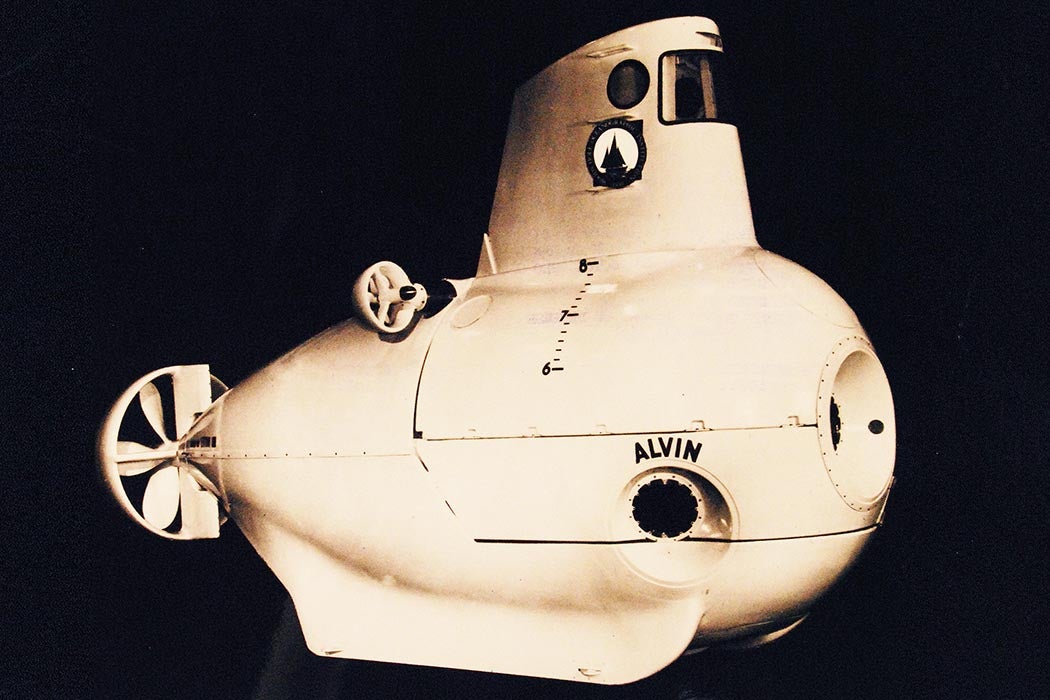The deep-sea submersible Alvin is sixty years old. Named after oceanographer Allyn Vine and built by a division of General Mills, the famed vessel has been substantially overhauled and upgraded several times since it was commissioned in 1964. The most recent upgrade was completed two years ago. Part of the Woods Hole Oceanographic Institution’s National Deep Submergence Facility, Alvin is still going strong. Which means deep.
Able to descend to 6,500 meters, Alvin has been a critical technological component in major discoveries in the field of oceanography. The vessel is probably most famous for its use in the confirmation of the existence of sea-floor hydrothermal vents at the Galapagos Rift in 1977. But that was only the beginning of the astonishment: the bubbling vents were surrounded by a thriving ecosystem, an entire biotic community in the dark of the ocean depths. The giant clams, six-foot-long tubeworms, and other lifeforms were based on foundation of chemosynthesis, not photosynthesis. This radical revision of the definition of life on Earth raised intriguing questions about the potential of life on other planets. More than 300 species have since been discovered around hydrothermal vents.
Some histories of Alvin have suggested that science propelled the vessel’s development. Historian Naomi Oreskes argues that it was actually the military. She explores the development of Alvin in the fascinating context of the “complexities of military-scientific collaborations” during the Cold War. Alvin was the “exceedingly expensive” product of the Office of Naval Research (ONR).
Founded in 1946, ONR was a major supplier of federal dollars for scientific research. At first, “when few within the Navy were paying attention to what it was doing,” ONR funded diverse research. (Alvin builder General Mills, better known as a cereal company, also had an aeronautical research division developing high-altitude balloons for ONR.) By the time of the setting up of the National Science Foundation in 1950, ONR was back on the track of its legally mandated mission to support research on behalf of the Navy’s mission. Alvin’s development was keyed to the demands of undersea warfare: protecting American submarines, tracking Soviet submarines. Oceanography per se wasn’t the point, oceanography for military purposes was.
“Oceanography in the 20th century, like the more well-known history of physics and space science,” Oreskes writes,
supports an alternative reading of the relationship between science and technology, basic and applied research, in which ‘application’ can be read as the driving force of fundamental discoveries about the natural world, rather than the other way around.
The Navy also needed deep-sea rescue and salvage capabilities. The USS Thresher’s loss off the coast of Massachusetts with 129 lives in 1963 underlined that. It took more than a year to locate the wreck of that nuclear-powered submarine. Alvin was commissioned in Woods Hole, Massachusetts, a few weeks after the Thresher’s discovery.
Weekly Newsletter
Alvin’s first mission in 1965 after testing and shake-down was, in fact, classified. The details weren’t publicly revealed until 2002: the vehicle was used to inspect the Artemis hydrophone array, designed to listen for Soviet subs, off Bermuda. In early 1966, in the face of heavy demand and scheduled uses by scientists, the Navy showed again who was boss by enlisting Alvin in a two-month search for a nuclear bomb lost off the Mediterranean coast of Spain as the result of a mid-air collision between a bomber and a tanker. One of the bomb-retrieval attempts ended up ensnaring Alvin in the bomb’s parachute. Fearing a loss of Alvin’s civilian crew—the Palomares Incident, as the crash became known, was already a public relations disaster—the Navy deployed a remotely operated vehicle designed to recover the bomb.
An accident in late 1968 sent Alvin itself sinking into the deep just after the crew scrambled out at the surface. The craft was on the ocean floor for almost a year before being retrieved—by another deep-sea submersible, named the Aluminaut because it was constructed to show off the benefits of aluminum. Aluminaut was retired in 1970 and is now a museum piece, but the indefatigable Alvin was overhauled and put back into commission…where it remains.







